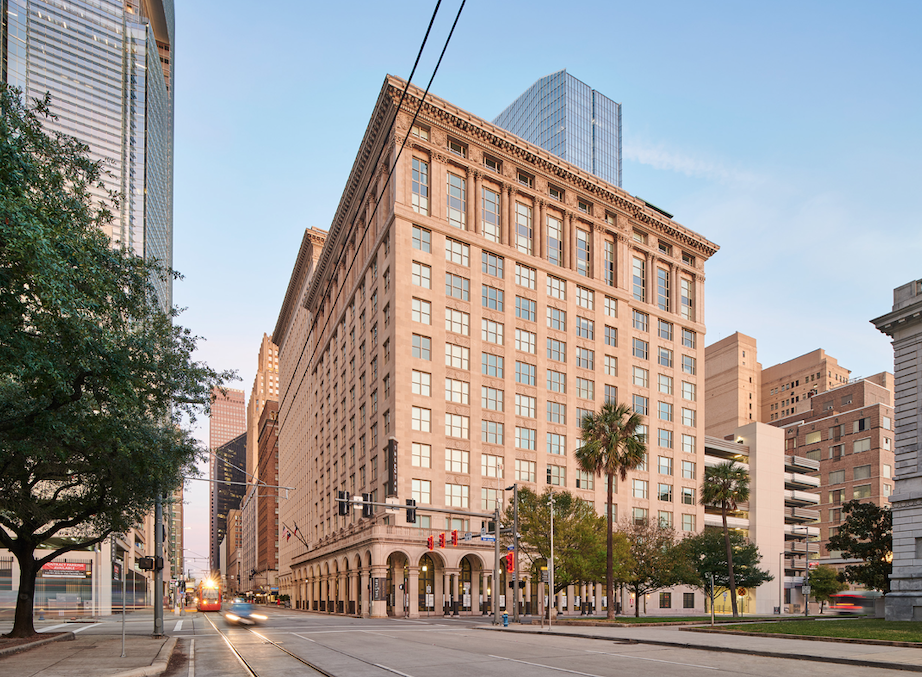After sitting vacant for nearly three decades, the former home of Texaco, Inc. has been converted into a 17-story, 286-unit apartment building in the heart of downtown Houston.
Dallas-based Provident Realty Advisors, which led the $99.5 million enterprise, renamed the property “The Star” as a tribute to the oil giant’s logo—“the big bright Texaco star!” in the old advertising jingle. The redevelopment came on the heels of several unsuccessful attempts to turn the building into a hotel in the years following Texaco’s relocation to the Houston suburbs in 1989.
“It was a beautiful but derelict building right in the center of the new downtown core, surrounded by new office developments, shopping, entertainment, and nightlife,” said Kip Platt, Director of Development and Acquisitions at Provident Realty Advisors.
The Renaissance Revival–style building features a brick, terracotta, and limestone façade, with signature vaulted arcades at street level that promote pedestrian activity. The original 13-story building, completed in 1915, was designed by Warren and Wetmore, a New York architecture firm whose portfolio includes Manhattan’s Grand Central Terminal. A 1938 annex expansion and a 16-story addition, completed in 1958, bulked up the structure to fill a city block. In 2003, the building was placed on the National Register of Historic Places.
The redevelopment team worked closely with the National Park Service and the Texas Historical Commission to qualify for federal and state historic tax credits. The Star was also the first project to benefit from Houston’s new Downtown Living Initiative, which awards $15,000/unit in tax incentives to developers who create new residential projects in the urban core.
 At one time a “ beautiful but derelict building,” according to developer Kip Platt, Provident Realty Advisors, The Star now provides 286 luxury apartments in downtown Houston. The original 17-story structure, completed in 1915, was placed on the National Register of Historic Places in 2003. Photo: Peter Molick
At one time a “ beautiful but derelict building,” according to developer Kip Platt, Provident Realty Advisors, The Star now provides 286 luxury apartments in downtown Houston. The original 17-story structure, completed in 1915, was placed on the National Register of Historic Places in 2003. Photo: Peter Molick
“Most of the structural elements were in really good shape. The building just needed some thorough cleaning, repair, and restoration,” said Robert Jurbergs, AIA, LEED GA, Principal at HBG Design, the Memphis-based architecture firm that oversaw the redesign.
HBG followed strict historic preservation requirements in restoring the structure’s distinctive features, notably its limestone columns, mosaic tiles, decorative chandeliers, bronze grilles, and historic clock. To improve thermal performance, the project team added exterior envelope insulation and specified new energy-efficient windows. “We went back to the original blueprints to ensure the new window profiles were as true to the original wood detailing as possible,” said Jurbergs.
The most pressing problem was how to fit a high-efficiency mechanical system with an additional layer of plumbing, fire protection lines, and mechanical ducts for apartments into a century-old office building.
According to Mark Weaver, FAIA, Principal at HBG Design, the project team circumvented this obstacle by building a 66,000-sf extension on the back side of the original L-shaped building, where historic preservation restrictions were less stringent. This gave them five more high-ceiling apartments with balconies on each floor. They also carved out a cozy outdoor courtyard for a heated, resort-style swimming pool.
The project team squeezed in a nine-level, 750-space parking garage for use by both residents and the general public. The Star sits on the city’s light rail system and ties into the Houston tunnel system, a network of subterranean pedways that links 95 city blocks.
STEPPING BACK INTO HISTORY
The Star’s interior spaces blend contemporary styling with intentional nods to its origins. Large-scale historical photos of the original structure are prominently displayed in the majestic ground-floor lobby. The original Texaco brass elevators have been emboldened with a black geometric design that runs throughout the building.
“It made sense to highlight this amazing, architecturally significant building rather than trying to hide it or make people think it was a new building,” said Lauren Parsons, a design and branding consultant who led the interior design of the amenity spaces. “I wanted it to have a timeless look.”
 Photos of Albert Einstein, Muddy Waters, and others linked to the year 1915 embellish the 17th-floor amenities space, which has a lounge, display kitchen, and Equinox-inspired fitness center. Photo: Lauren Parsons
Photos of Albert Einstein, Muddy Waters, and others linked to the year 1915 embellish the 17th-floor amenities space, which has a lounge, display kitchen, and Equinox-inspired fitness center. Photo: Lauren Parsons
Parsons lived in the building as it was being completed. She curated an eclectic mix of Texaco memorabilia from former employees and collectors for display in the expansive basement game room and lounge area, a dimly lit space that takes its cue from Prohibition-era speakeasies.
The property has 207 one-bedroom and 79 two-bedroom units, with 22 different floor plans ranging from 730 to 1,730 sf, on levels two through 16. Apartments have 11-foot ceilings, quartz countertops, custom cabinetry, stainless steel appliances, and oversized soaking tubs. Monthly rents range from $1,750 to $3,860.
A 1915 design motif extends to the building’s 17th-floor penthouse level, which showcases large-scale black-and-white portraits of Billie Holiday and other cultural figures loosely linked to the year the original building was completed.
AN INTERESTING MIX OF TENANTS
The location can’t be beat. The property is adjacent to the city’s shopping and historic districts and located within 160 feet of 8,000 jobs. The Star is about 90% leased, according to Provident Realty Advisors’ Platt.
“It’s an eclectic group of people who live in the building—from professional basketball players, to artists, to attorneys,” he said. “Anybody can go live in a shiny glass high-rise, but you can’t duplicate the look or character of a historic building. There’s just a unique vibe to it.”
On the project team
DEVELOPER: Provident Realty Advisors ARCHITECT HBG Design INTERIOR DESIGNER Lauren Parsons MECHANICAL/PLUMBING ENGINEER Haltom Engineering ELECTRICAL ENGINEER DePouw Engineering ELEVATOR CONSULTANT Lerch Bates Company GC Provident Realty Advisors Construction
Related Stories
Office Buildings | Jun 28, 2023
When office-to-residential conversion works
The cost and design challenges involved with office-to-residential conversions can be daunting; designers need to devise creative uses to fully utilize the space.
Multifamily Housing | Jun 28, 2023
Sutton Tower, an 80-story multifamily development, completes construction in Manhattan’s Midtown East
In Manhattan’s Midtown East, the construction of Sutton Tower, an 80-story residential building, has been completed. Located in the Sutton Place neighborhood, the tower offers 120 for-sale residences, with the first move-ins scheduled for this summer. The project was designed by Thomas Juul-Hansen and developed by Gamma Real Estate and JVP Management. Lendlease, the general contractor, started construction in 2018.
Affordable Housing | Jun 27, 2023
Racial bias concerns prompt lawmakers to ask HUD to ban biometric surveillance, including facial recognition
Two members of the U.S. House of Representative have asked the Department of Housing and Urban Development to end the use of biometric technology, including facial recognition, for surveillance purposes in public housing.
Apartments | Jun 27, 2023
Average U.S. apartment rent reached all-time high in May, at $1,716
Multifamily rents continued to increase through the first half of 2023, despite challenges for the sector and continuing economic uncertainty. But job growth has remained robust and new households keep forming, creating apartment demand and ongoing rent growth. The average U.S. apartment rent reached an all-time high of $1,716 in May.
Apartments | Jun 27, 2023
Dallas high-rise multifamily tower is first in state to receive WELL Gold certification
HALL Arts Residences, 28-story luxury residential high-rise in the Dallas Arts District, recently became the first high-rise multifamily tower in Texas to receive WELL Gold Certification, a designation issued by the International WELL Building Institute. The HKS-designed condominium tower was designed with numerous wellness details.
Multifamily Housing | Jun 19, 2023
Adaptive reuse: 5 benefits of office-to-residential conversions
FitzGerald completed renovations on Millennium on LaSalle, a 14-story building in the heart of Chicago’s Loop. Originally built in 1902, the former office building now comprises 211 apartment units and marks LaSalle Street’s first complete office-to-residential conversion.
Urban Planning | Jun 15, 2023
Arizona limits housing projects in Phoenix area over groundwater supply concerns
Arizona will no longer grant certifications for new residential developments in Phoenix, it’s largest city, due to concerns over groundwater supply. The announcement indicates that the Phoenix area, currently the nation’s fastest-growing region in terms of population growth, will not be able to sustain its rapid growth because of limited freshwater resources.
Multifamily Housing | Jun 15, 2023
Alliance of Pittsburgh building owners slashes carbon emissions by 45%
The Pittsburgh 2030 District, an alliance of property owners in the Pittsburgh area, says that it has reduced carbon emissions by 44.8% below baseline. Begun in 2012 under the guidance of the Green Building Alliance (GBA), the Pittsburgh 2030 District encompasses more than 86 million sf of space within 556 buildings.
Industry Research | Jun 15, 2023
Exurbs and emerging suburbs having fastest population growth, says Cushman & Wakefield
Recently released county and metro-level population growth data by the U.S. Census Bureau shows that the fastest growing areas are found in exurbs and emerging suburbs.
Engineers | Jun 14, 2023
The high cost of low maintenance
Walter P Moore’s Javier Balma, PhD, PE, SE, and Webb Wright, PE, identify the primary causes of engineering failures, define proactive versus reactive maintenance, recognize the reasons for deferred maintenance, and identify the financial and safety risks related to deferred maintenance.

















